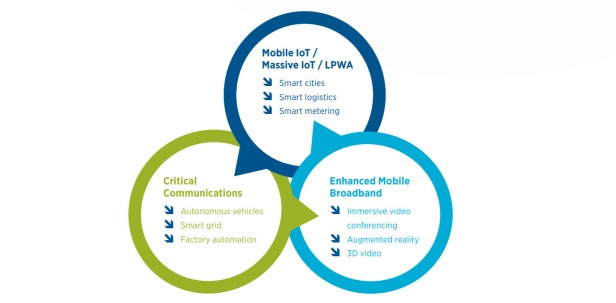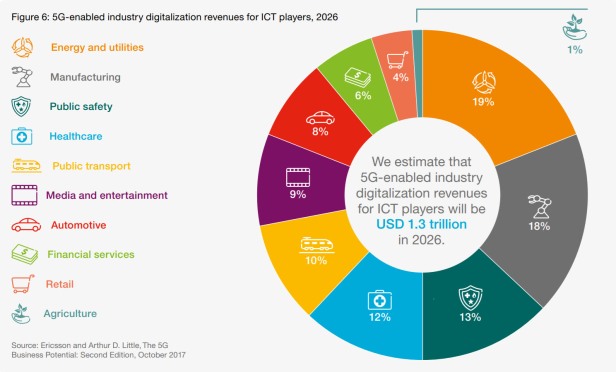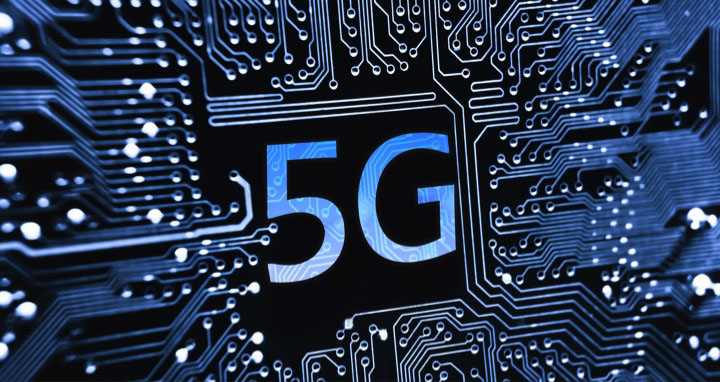Internet Of Things(IoT) has spread like wildfire, in this age of technology, with every industry incorporating it into their business models, and their products. This resulted in network congestion and high latency, in data transfer, making it almost next to impossible to implement in mission-critical use cases. A 100-millisecond delay in a car traveling at 75mph can lead to up to an additional 10 feet, before applying brakes, which can even cost a life. 5G aims to reduce the latency and increase network coverage via 3GPP standardized Low Power Wide Area (LPWA) networks using NB-IoT and LTE-M license spectrum bands.
What is 5G technology?
5G technology marks a radical shift in network architecture, by using various access technologies like WIFI, satellites, fixed line, and 3GPP to assist multiple use-cases. It will provide low latency, high capacity network coverage to connect devices on an industrial scale, with the help of LPWA technology. LPWA enables the most secure and reliable form of cellular communication, due to its simplified network topology with strong authentication, and its ability to upgrade its capacity. It sends small blocks of the data stream and consumes less power, thereby increasing its longevity. 5G is speculated to provide 10 times the speed of 4G network(up to 10 Gbps)
LPWA technology uses the following license spectrum bands to deliver its low cost, high network coverage capability. Both of these spectrums will eventually join the 5G NR(New Radio) frequency band.
LTE-M: LTE-M stands for Long-Term Evolution (LTE) machine-type communications (MTC) technology, and provides lower device complexity, extensive connection density, low latency and device power consumption. This enables the use of existing LTE installed base for the next generation of cellular network, i.e 5G. Introduced by 3GPP in Release 13, LTE-M can be’in-band’ with normal LTE carrier, or ‘standalone’ as a different spectrum
NB-IoT: NB-IoT stands for Narrowband IoT and is a 3GPP radio technology, introduced in release 13, that improves indoor coverage, low power consumption, low delay sensitivity and optimized network architecture. NB-IoT transfers sensor data directly to a cloud server, thus eliminating the need of a gateway, making it cost-efficient. It can ‘in-band’ with normal LTE carrier, ‘standalone’ as a different spectrum, or in an LTE carrier’s guard-band.
3 major use-cases of 5G wireless communication:
- Mobile IoT/Massive IoT(MIOT): MIOTis the solution for LPWA technology to provide ubiquitous connectivity, low-cost devices, and long battery life. NB-IoT and LTE-M enable extensive indoor and outdoor coverage, enabling better connectivity even in remote location. MIOT is achieved using small cells, that helps in Mobile Network Densifications. These small cells are operator-controlled low-powered mobile base stations and can handle traffic up to 20Gbps. it extends the network coverage to indoor areas, where outdoor signals can’t penetrate. In a Smart City, these cells are used in smart lighting, energy, air quality, and parking system, to handle high-density communication between connected devices. Due to its small size and low power consumption, it is less costly to deploy, can provide 100 times more connections, and is ultra energy efficient, i.e it can increase the battery life of IoT devices up to 10 times. It is also referred to as mMTC (massive Machine Type Communications).
- Enhanced Mobile Broadband(EMBB): EMBB is the solution for seamless user experience, with better connectivity. It allows faster access to broadband, that can be used for AR/VR streaming, immersive video conferencing, or real-time surveillance coverage. EMBB will be the first of three application of 5g technology and will be implemented on 4G installed base at first, and eventually getting upgraded to the 5g network model. Apart from proving faster downloads, it will improve the quality of services, provided by the cellular network, over a wide area of coverage. It will provide consistent connectivity access to a densely populated area, indoor/outdoor areas or in a moving environment, like cars, train, busses.
- Mission Critical Services(MCS): MCS is a solution to reduce latency among the connected devices, for time constraint environments. With 5G technology, the latency can be reduced to fewer than 10ms, thus enabling faster response time for time-sensitive circumstances, like autonomous vehicle communication, factory automation or real-time video monitoring of surgery. These mission-critical applications require less than 1ms latency with error rates less than 1 packet loss in 10^6 packets. It is also termed as Critical IoT, URLLC (Ultra Reliable Low Latency Communications). URLLC reduces latency by using grant free uplink resource to transmit data, without waiting for base stations to assign the resources. This reduces the number of handshakes between the base station and user equipment (UE), thus a faster communication between systems.

How will 5G impact IOT?
The most important use cases of 5G impact on IoT will be connected cars, smart cities, and healthcare. With low latency network, with high coverage and ultra-low cost, will revolutionize the IoT industrial world. The IoT-5g scenario will extend its capabilities to robots and drones for distributed coordination, with fast response time. Since 5g will extend over the existing 4g base, it will be cost-effective and migration would be easier. The new technology will provide connectivity with 10 times lower cost per gigabyte than the existing networks. Most of the IoT applications will use small cells for network diversification, and cities will play a major role in that.
Following are some of the sectors, in which 5g will impact IoT the most:
- Automotive: Enhanced vehicular communication services will be made efficient with the help of 5G, by providing faster response time, to the data collected from the sensors. All the connected vehicles communicate with other vehicles, pedestrians (V2P), infrastructure(V2I) and networks(V2N) to build a full vehicle-to-everything(V2X) communication. 5G will enable this communication with reduced latency(<10ms), to provide a safer and coordinated driving, without human intervention.
- Industrial: 5G will enable secure networks for Industrial IoT, by integrating security in the core network architecture. It would also allow real-time communication between machines, with reduced latency, thus enabling remote inspection. All the machines will be interconnected with the help of sensors so it will become easy to find the defective piece on the factory floor and provide maintenance, with least cost expenditures.
- Healthcare: 5G will enable IoT to perform mission-critical services like real-time monitoring of surgery by doctors sitting anywhere in the world. The reduced latency will allow faster response time, thus making it safer to monitor and operate on such scenarios. It will also help in storing and retrieving secure patient data, with the help of smart sensors like smart beds, syringes, and medicines, to monitor them. Ambulance drones will make it easier to send and receive supplies.
- Energy and utilities: 5G will allow newly advanced infrasture to integrate with the existing ones, thus reducing the cost of development. Using smart meters, Energy usage can be monitored and reduced. Integration sensors in microgrid and distributed generation will handle the collection of large sets of data and provide necessary feedback to deploy an energy efficient system. Cities can use smart lighting and grid system, to reduce the overall energy consumption, making the whole system sustainable for a longer time.
- Public safety: Real-time monitoring of surveillance footage, with reduced latency will speed up the response time to emergencies. Low-cost devices will allow more systems to be set up, thereby increasing the reliability and accuracy of the data. A real-time smart video surveillance can capture videos and still in multiple angles, which will ensure the correct perpetrator is captured, thus enhancing public safety.
- Retail: 5G will help in setting up automation in a retail environment, like barcode scanning, retail management, thus providing real-time analytics on trends and sales. This will enable the market to deliver more customer-centric products. Putting AR/VR in the store, allows users to test the product virtually, providing feedback and customer support, thus increasing their satisfaction. Automated warehouses with logistic management will also be made efficient with the help of 5G.
- Agriculture: 5G can automate various tasks in agriculture fields like farming and harvesting while optimizing the logistics chain with the help of sensors and analytics. Interconnected devices will enable more efficient functioning and better crop yields. Live supply chain tracking is made possible with the help of faster and consistent network.
- Financial services: 5G and IoT will lead to next generation of user-based insurance, and provide security to personal and financial data, with High-security cloud-based services. Connecting to remote financial advisors will become more seamless, while real-time mobile trading will become a norm for every businessman. 5G will also improve the IT infrasture, to enable faster and secure transactions.
- Public transport: 5G can help in reducing congestion on the route, by provding real-time traffic information to the driver, collected from different IoT sensors. Real-time video surveillance in public transport will ensure public safety, while
- Media and entertainment: 5G will provide faster internet access using a high-density wireless fixed internet, which will enable better video streaming quality and faster downloads. Increasing the connectivity between all devices will make sharing easier over the internet, while AR/VR usage will rise exponentially, due to low latency and higher speed.

Conclusion
Internet of Things will constitute a quarter of expected 5G connections by 2024, as predicted by Machina Research, out of which, three quarters will be in the automotive industry. Ericsson studies state that by 2021, 70% of the companies will incorporate 5G into their IoT business models. While it has to suffer early development challenges like working on multiple spectrum bands, migration from LTE to 5G while ensuring data interoperability, but it is still expected to be ready completely by 2021. Trials have already started, with 3rd Generation Partnership Project (3GPP) release 15 aiming to integrate enhanced Mobile Broadband (eMBB) use-cases, as the first application of 5G application. Carriers have started implementing NB-IOT and LTE-M on their 4g base, to allow migration to full 5g spectrum easier.


Wow, I have learned so many new things today. Thanks for the elaborate explanation.
LikeLike
And I thought 4G was the ultimate speed you can have! Now I am looking forward to 5G! We are heading to a word where smart devices will be more and more present in our lives.
LikeLike
5G sounds amazing. I like this improvement in my technology and it maybe time for a new phone.
LikeLike
I would love 5G! Sometimes I feel like 4G isn’t fast enough. I hope we can go to 5G at some point!
LikeLike
Wow 5G looks like it would be really cool, especially due to the speeds that it provides — and the many areas we could use it for. I would love to see it happen soon.
LikeLike
Wow 5G looks amazing! Here in Philippine we only have 4g LTE! Nice article of you.
LikeLike
Sometimes I feel 4G isn’t fast enough. I wish to have 5G now. It looks amazing.
LikeLike
I feel very out of the loop with these things. This has been very helpful in learning!
LikeLike
This is so cool. I cannot wait to experience the power of 5G. Can’t wait to upgrade to it.
LikeLike
The rate at which we’re progressing with technology is blowing my mind. Thanks for keeping me on top of things!
LikeLike
I’m so out of the loop! 5G sounds like it could be really great!
LikeLike
Sounds so amazing, technology just always gets better and better. 5G sounds awesome.
LikeLike
Oh my. I haven’t event fully understood what 3G is and now we have 5G, All I know is that if I see the 4G sign on my phone,, I get better signal.
LikeLike
Oh wow. This looks promising. So I guess we will get more speed and information? We really can’t stop the advancement of technology now.
LikeLike
I have heard about the Internet of Things for awhile now, but was not aware of 5G technology. It shouldn’t be surprising, though, as technology continues to advance..almost without our help (the scary part!)
LikeLike
It is so alarming with the rate at which technology is taking over almost every of Man’s doings…
Especially internet!
When I read lost like this, I’m always happy because it’s a privilege to be among the change adopters of this new Era
LikeLike
I highly doubt 5g will hit Australia any time soon. We’re a bit behind in the times. They just rolled out the NBN network which was a massive failure as it hasn’t helped speed up internet speeds at all.
LikeLike
Am not sure when my neck of the woods will jump on 5G
LikeLike
I’m looking forward to get 5G.
LikeLike
5G should be great for Broadband usage can’t wait we all want faster internet service
LikeLike